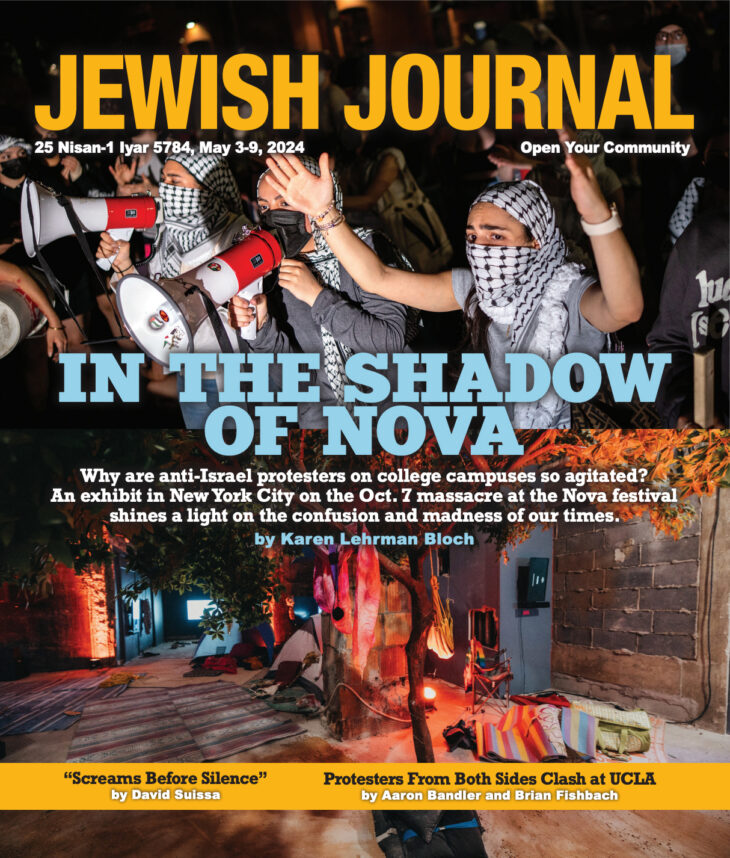Construction of an eruv in the Conejo Valley was nearly complete last month when area residents began complaining to public officials about aesthetics and safety concerns as well as a lack of proper permits. Last week the eruv’s organizers ordered all remaining portions along the enclosure’s 5-mile perimeter be dismantled.
“We are sorry that mistakes were made and that the eruv was put up in an incorrect way,” Eruv Committee spokesman Eli Eisenberg told a hostile crowd of about 60 Conejo residents during the Oak Park Municipal Advisory Council (MAC) meeting on Jan. 23.
The Agoura Eruv, a project conceived by a small group of local Chabad congregants, covered portions of Agoura Hills and Oak Park, as well as a small sliver of Westlake Village. The Oak Park segment of the eruv had been taken down prior to the Jan. 23 meeting, and on Jan. 25 the Eruv Committee officially ordered the elements in Agoura Hills and Westlake Village dismantled.
Emotions have died down considerably since the removal of the eruv, a project that took three years of planning and cost at least $25,000. Still, questions linger about how such a commitment of time, money and expertise could have ended so badly. And after the Oak Park MAC meeting, many Conejo residents are wondering whether the Eruv Committee will try again.
“I’m happy now that it’s down,” said Tom Hughes, president of Morrison Estates Owners’ Association, representing a development of 360 luxury homes in Oak Park. “Nobody liked it,” he added, calling it a “blight” and questioning its safety.
An eruv, which literally means “blending” in Hebrew, uses a monofilament line strung across utility poles as well as existing boundaries, such as mountains and freeway walls, to transform a public space into a symbolic private one.
Observant Jews put up eruvs to allow themselves boundaries in which they can carry children and keys, for example, or push strollers and wheelchairs without violating the laws of Shabbat.
Consultant Howard Shapiro, who served as project manager of the 50-mile Los Angeles Eruv and consulted on three others, was contracted by the committee to design the Agoura Eruv. Shapiro used existing boundaries whenever possible and noted that up to 70 percent was contained by such borders.
Construction on the Agoura Eruv began during the last week of December 2006. Shapiro hired a contractor who installed the eruv, giving the contractor’s name as Rafael Farias of Coast to Coast Installation, and saying he had worked with Farias on four previous eruvs.
In Oak Park, where the utilities are buried underground and only light poles edge the roads, additional 20-foot poles, called lechim, had to be erected to string the monofilament line. Residents objected to the obtrusive appearance of the poles, especially along Jacobs Court near Lindero Canyon Road. Plus, several poles were placed on private property without prior permission and others were attached to street signs. Residents also felt the line itself, in an area with few overhead wires, was unsightly and hazardous.
Shapiro attributed part of what he called the “lynch mob” reaction of many residents to a clash of cultures.
“This is a different community,” Shapiro said. “In L.A., there are overhead wires everywhere. No one’s going to care. Here it’s very noticeable.”
Shapiro also said that he thought Tom Block, an Agoura Hills resident who initiated the eruv and organized the committee, understood how the finished eruv would look, having toured the area several times together.
“But it’s one thing to talk and another to see,” said Shapiro, who maintains that the eruv was installed correctly.
Block, a formerly secular Jew who has become more religiously observant over the past 15 years, admitted that in hindsight he didn’t really understand what a “lechi,” or pole, was.
But perhaps most problematic were the permits. Block submitted permit applications to the cities of Agoura Hills and Westlake Village, both in Los Angeles County, and, for Oak Park, to the Ventura County Transportation Commission.
He also submitted a plan to Southern California Edison, which has jurisdiction over all the light poles that would be affected, with a detailed map of the entire area to be enclosed by the eruv. On the permit itself, however, only the city of Agoura Hills was listed, with Oak Park and Westlake Village left off.
“Everyone was on the same page and knew it was for the whole area I had mapped out,” Block said, calling it an “accidental omission.” But when a few vocal neighbors in Oak Park started making a fuss, Ventura County revoked the permit, saying it had been contingent on Southern California Edison’s permission.
Some residents were also upset that three red-tailed hawks, which are protected by the Migratory Bird Act, had been downed, one fatally, by injuries that could be consistent with flying into a wire. The birds were discovered between Dec. 28 and Jan. 7, according to Oak Park resident Peggy Abate, which correspond to eruv construction dates.
“To me, it’s not an issue of whose fault it is. There were mistakes made by everyone involved,” Block said. “I’m willing to take responsibility.”
The Agoura Eruv would have served the bulk of families who attend Shabbat services at Chabad of Agoura Hills and Chabad of Oak Park, both part of Chabad of the Conejo. But committee spokesman Eisenberg emphasized that construction of the eruv was not a Chabad undertaking.
“Rabbi [Moshe] Bryski made it clear from the very start that he would only support the eruv if it is done outside of Chabad as a community-based effort,” said, referring to Chabad of the Conejo’s executive director.
Since the Eruv Committee never officially incorporated, Bryski agreed to lend Chabad’s name to the permit and insurance applications and to provide rabbinic advice as needed.
Eruvs are not new to Los Angeles. In addition to the Los Angeles Eruv, which comprises a large portion of the San Fernando Valley, smaller ones exist.
Also, after four years of negotiation, an eruv was recently approved for the Venice area, extending along the coastline. In the West San Fernando Valley, an eruv enclosing a 25-square-mile area is expected to be completed in late February.





















 More news and opinions than at a Shabbat dinner, right in your inbox.
More news and opinions than at a Shabbat dinner, right in your inbox.